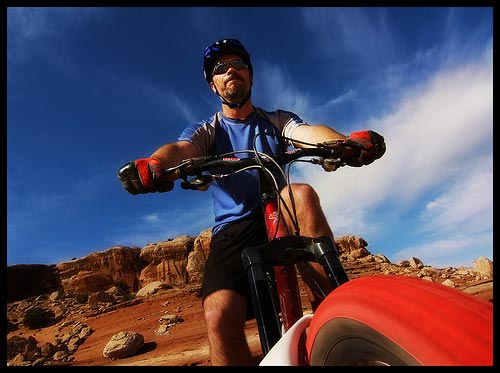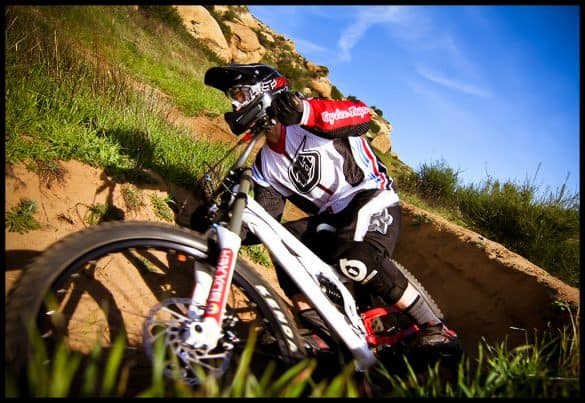This is the second article in a series of guest posts by Keith Pytlinski. Keith has shot for numerous bike magazines and professional publications…so needless to say…this guy REALLY knows what he is talking about. Mountain biking photography is a hobby of mine and a lot of the riders I ride with…so I found this invaluable information a must post. You can check out more of Keith’s work over at M5 Photography. Here is part 1 and part 3.
Transporting your camera on rides
Before we get into any of the technical details of photography, there are a few things that I left out of Part 1 that I want to cover. A major concern for many camera owners is how to transport their camera. I’m going to share the things that work best for me. If you already have a method of transport that works well, then stick with it. Starting with my smaller Canon point and shoot camera, I place it and a second battery (more on this in the next section) in a simple small case and drop it into one of the front pockets in my Camelbak. I’ve seen others attach smaller cameras to the outside of their pack near the shoulder or run a system that attaches it to their waist. For me I like the peace of mind knowing that my camera is in what I see as a safer place stashed in my pack. Yes, it takes me more time to access my camera, but again, it feels a bit more protected on my back.
There seems to be even more concern with people who shoot with SLRs. Hopefully, knowing there are others bringing their SLR on rides will ease some of that worry. When I carry my SLR, I use the same method of placing it in my Camelbak, but instead of a camera case I use a R.A.P by Skooba. The RAP product allows some shock protection, some water resistance and is less bulky than an SLR case would be. I’ve been using this method for a number of years and have yet to have any issues. Again, you’ll find what works best for you; these are some transport options that have worked for me over the years. The bottom line here is that you shouldn’t be afraid to take your camera with you.
I mentioned above that I bring a second battery with me on my rides. I think this is an often overlooked topic and can make or break your day of shooting. Many of us forget to charge our main battery the night before, and a second battery can save your butt when that primary runs out or you forgot to charge it. SLR batteries are on the pricey side; I’d like to suggest you visit http://sterlingtek.com/. Their batteries are substantially cheaper than the brand name, and I’ve yet to have any issues with the quality.
Labeling your camera equipment
Oh look, a free camera! This is probably what someone said when I left one of my first digital cameras on a trail in Mammoth Mountain a few years ago. There was no way the person who found it would have known it was mine. This was a life lesson and one that I try to share with anyone doing photography. The solution I’ve found to work best is labeling my equipment with the following:
Reward if returned
Keith@m5photography.com
My phone number
I used to use the return address labels that you use to mail envelopes on my gear, but I found they didn’t last long. I have since discovered ID My Stuff from the folks at Maverick Label. The ID My Stuff labels come in four different sizes and they seem to have a size that fits all my equipment. I use these on my camera bodies, lenses and flash units. Of course there is no guarantee that the person who finds your gear will call or email you, but at least you’ve got that information on there.

Canon DSLR Lens Label
How to shoot when riding solo
In Part 1, I suggested bringing your camera even when riding solo, but I didn’t offer up any suggestions on how to shoot when alone. First let me say that we can only look at so many shots of your bike on the ground or leaning on a fence. We want to see a rider in that shot! A great way I’ve found to shoot alone is by bringing along a tiny tri-pod. The Ultrapod II is one that I’ve used for years and I love its features. It’s small, lightweight, folds up nicely and takes little room to store. It is also strong enough to hold up your SLR and a small lens. These shots will take some practice, but with some effort on your part you can get great results. Find that great background, set your camera on your mini tripod, set the self timer, and dash back to your bike for the shot. Typically the self timer will have two options for time. Play with this feature and of course choose the longer timer.

Canon DSLR on Ultrapod II
The Technical Side of Shooting Pictures
Well I’m hoping since you read through Part 1 that you went out and tried some new angles with your camera and challenged yourself with getting something different. I promised to get into the more technical side of using your camera, and for this we are going to go on an internet field trip. The main goal is to get you comfortable making changes to your camera’s settings and get you out of the habit of shooting in full auto all of the time. Darren Rowse over at Digital Photography School (DPS) has already done an outstanding job covering shutter speed, aperture and ISO. I’d suggest taking your time in reading these, seeing where these settings are on your camera and even making a small cheat sheet you can bring with you on rides. So head on over to DPS. You can use that information to see which settings I used on the pictures below and why.
Shutter Speed: http://digital-photography-school.com/shutter-speed
Aperture: http://digital-photography-school.com/aperture
ISO: http://digital-photography-school.com/iso-settings
I understand the effort it took Darren to complete those articles; a huge thank you goes out to him and DPS.
Now that the tech side has been covered, let’s look at some real world examples in mountain biking photography. In the photo examples below I will explain the shot I wanted and how I got there.
Picture Examples and Explanations
Keep in mind that this is only a tiny example of the types of shots you can get while riding and shooting.

Photo01 – Mountain Biking Photography
Photo 1 above was taken with my small Canon point and shoot camera. I read some feedback from my first post about a SLR being a must, I don’t agree with that statement as I’ve captured many of my favorite shots using my point and shoot. For this shot my first challenge was finding the angle that I thought would be different. I typically will take a look without the camera and envision the shot in my head, then take a look through the view finder or LCD. I wanted to shoot something low as the stairs were the main feature here. I knew if I used too fast a shutter speed that it might look like the rider was simply balancing on the stairs, so I slowed the shutter speed down enough to allow for some motion blur.
The second challenge in this shot was having enough light. You may be able to tell that this was shot beneath a tree. The fact I was using a slower shutter speed did help in this case. Increasing the ISO here would also have allowed me to get the light that was needed for this shot. Some will say using the flash would be another option here. I agree but the flash on the smaller point and shoot cameras can be a bit harsh and hard to control. Again you will find there isn’t one single correct way to get your shot and I think that is one of the cool things about photography.
The take aways from this example:
- Small cameras can get the job done.
- Choose the angle
- Slow shutter speed for some motion blur.
- I chose not to use the flash in this case.

Shot 2 – Mountain Biking Photography
In shot 2 above I was able to use one of my suggested techniques mentioned in Part 1. I was able to ride out ahead of the group, find what I thought to be an ideal location and set up for the shot. In a landscape and rider combo shot like this, one thing to keep in mind is you often want the foreground and background to be in focus. The solution here was choosing to use a smaller aperture. The use of a smaller aperture allows for the entire scene to be in focus which is what I was looking for in this shot. A larger aperture would have had the rider in focus and the background blurred.
The take aways from this example:
- Ride ahead, choose the spot.
- Get your settings dialed.
- Choose a smaller aperture to allow for everything in the shot to be in focus.

Shot 3 – Mountain Biking Photography
Shot 3 came with a few of its own unique challenges. Again the first task was to find an angle that I thought would work best and hopefully be a bit different. It’s hard to tell from the actual photo, but I am tucked down below the ledge on the left as low as I could get. The sun in this spot was less than ideal as it was at the riders back causing the rider to be back lit. I did my best to compensate for the dark front of the rider by using a larger aperture, but not so much that the sky was totally blown out. I also wanted to keep the shutter speed high enough that I could get a sequence of shots and stop the motion of the rider. This is a good example of being in position, having your camera settings dialed in and being ready for anything.
The take aways from this example:
- Find that unique angle.
- Know your settings to adapt for challenging light.
- Higher shutter speed to stop the action.
- Be prepared for anything to happen.

Shot 4 – Mountain Biking Motion Shot
When shooting cross country races you don’t usually come home with the most exciting photos. I’m hoping this one gets you thinking for the next time you are out shooting something that isn’t considered exciting. In shot 4 I decided I was going to experiment with some really slow shutter speeds and hopefully get something with movement that would create that sense of action. Normally with very slow shutter speeds and movement everything in the photo would be blurry. In this situation I used the flash to stop the action. It’s a bit more of an advanced technique that wasn’t covered in our field trip, but I wanted to give a good illustration of trying to be creative and using slower shutter speeds. I’ll cover some flash information in part 3.
The take aways from this example:
- Try something new if you are bored.
- Play with shutter speeds.
- Use the flash to stop the action. (More on that in Part 3)

Mountain Biking Photography
I feel this last example conveys many of the points I’ve talked about so far. In this shot I really went for the creative angle (I will cover how I did that in part 3), used a slow shutter speed to show motion with the blurred tire and chose an aperture that would allow for focus in the foreground and background. This maybe more on the advanced side but again hopefully it inspires you to get out there and try some things on your own.
The take aways from this example:
- Again find a unique angle.
- Know your how to change your settings to get the desired shot.
- A smaller aperture allowed for both the foreground and background to be in focus.
- Slow shutter speed for motion blur.
Thanks for reading! In Part 3 I’ll cover China Bees, Pocket Wizards and Magic Arms…..oh my.
You can check out more of Keith’s work over at M5 Photography.


4 comments
the information is very useful. thanks.